[Retracted] Analysis and Application of Quality Indicators in Hospital Administrative Management Based on a Fuzzy Hierarchical Model
Abstract
The core competitiveness of a hospital lies not only in the competition of medical environment, medical technology, and service level but also in the management concept and management level. The decision-making ability, management ability, organization and coordination ability, and innovative thinking consciousness of hospital administrative cadres, both subjectively and objectively, determine the future development and performance of the hospital to a certain extent. Based on the fuzzy hierarchical model, this article analyzes the quality indicators of hospital administration management and finds that in the first-level indicators, work performance and work ability are more important than other indicators; in work performance, goal achievement, work efficiency, and work quality are relatively important. It is necessary not only to ensure the achievement of goals but also to ensure the quality and efficiency of the work; in the work ability, the execution ability and management ability have the largest weight value, so in the process of administrative management, we should focus on cultivating the execution ability and management ability; in the work attitude, the overall concept and leading by example have the greatest weight, so it is necessary to focus on the overall situation and lead by example; in satisfaction, employee satisfaction has the greatest weight, so it is necessary to pay attention to employee satisfaction in order to better retain talents. According to the department’s management responsibilities, postcharacteristics, and daily assessment, according to the weights determined by the index system in the management line, and through expert points, the index weights are adjusted for departments with different work characteristics and their actual work conditions. Therefore, in the service guarantee department, the weight of work performance is 30%, the weight of work ability is 20%, the weight of work attitude is 25%, and the weight of satisfaction is 25%. In the technical management department, the weight of management ability is adjusted to 30%, the weight of coordination ability is adjusted to 5%, and the weight of innovation ability is adjusted to 5%. In party and government management, the weight of executive power is adjusted to 30% and the weight of analysis and discrimination ability is adjusted to 5%. In the service guarantee, the weight of adaptability is adjusted to 20%, the weight of coordination and communication ability is adjusted to 15%, the weight of analysis and judgment is adjusted to 15%, and the weight of management ability is adjusted to 10%. By establishing a quality index system suitable for hospital administrative management, the current common phenomenon of low work efficiency, large waste of manpower and material resources, and dependence on “waiting, letter, and inquiry” in hospitals can be changed, and the enthusiasm of hospital management cadres can be mobilized to achieve their goals. Give full play to the multiplier effect of hospital management and improvement, and realize the sustainable development and overall competitiveness of the hospital’s overall long-term strategic goals. The implementation of the new medical reform strategy has driven the development and commitment of the medical and health service industry. The development of market economy has become a new challenge as a safe, efficient, convenient, and low-cost way of providing health care services to the masses. The core of hospital competition is not only the competition of medical environment, technology, and medical service but also the competition of concept management and management level. Decision-making ability, leadership ability, organization and coordination ability, and the understanding of the new thinking of hospital management structure determine the future development direction and performance level of the hospital to a certain extent.
1. Introduction
Failure Mode and Effects Analysis (FMEA) is one of the well-known quality management techniques used to continuously improve product or process design. When using this technique, setting a risk priority number (indicating the level of risk associated with a potential problem) is critical to the success of the application. These numbers are often based on past experience and technical assessments, and this approach to risk assessment can sometimes lead to incorrect and conflicting prioritization numbers. When assigning risk priority numbers, an ambiguous logical approach is preferred to eliminate these pitfalls. In this study, fuzzy FMEA was used for the first time to improve the procurement process in a public hospital. The results show that the use of the fuzzy FMEA method can solve the problems encountered by the traditional FMEA, effectively discover the potential failure modes and effects, and also ensure the stability of the process [1]. Hospital performance is a key factor for the success of hospital management, but hospital performance is always uncertain and ambiguous, so formulating scientific evaluation methods has become the main obstacle to effective hospital management. The article presents a complete evaluation method. This method is based on AHP, uses fuzzy cluster analysis to sort the index system, then uses fuzzy analysis to give the scores of all indicators, and finally combines the scores of all these methods to get general results [2]. The Administrative Service Center (ASC) is a newly established public service organization in China. Zhejiang ASC conducted a survey in 2005 and collected a total of 915 samples. The article proposes the use of Hierarchical Linear Modeling (HLM) to study factors affecting services. First, the evaluation is given; second, the conceptual model and assumptions are given; third, the research process is described, including variable design, data selection and collection, reliability and validity, and model estimation. The conclusion is that CSA has direct and indirect effects on the service industry, but the relatively dominant driver of the service industry is the traditional sector. Therefore, some related suggestions are put forward to confirm the status quo of CHW and improve customer satisfaction [3]. This paper briefly introduces the historical development of total quality management and its basic working principles and methods in enterprises and introduces the successful experience of implementing TQM in the United States, Germany, Japan, and Taiwan; also, the specific steps and precautions for implementing TQM in hospitals were discussed. The purpose is to help national hospitals to implement total quality management [4]. The evaluation of travel website service quality (TWSQ) is a multicriteria decision-making problem (MCDM) with strategic implications for travel-related businesses. In real life, decision makers (DMs) encounter a wide variety of TWSQs that are often ambiguous with human subjective judgments. Traditional TWSQ notation methods are insufficient to deal with language notation errors or ambiguities. To overcome this difficulty, the purpose of this study is to propose a hierarchical MCDM evaluation model based on the fuzzy analytic hierarchy process (FAHP) and Ideal Solution Similarity Order Preference Fuzzy Technique (FTOPSIS). The weights of the criteria and the ranking of the alternatives are evaluated by linguistic (natural) variables represented by obscure triangular numbers. Finally, four representative travel websites are provided in Taiwan to illustrate the usefulness of this model. Furthermore, the findings will help station managers to understand their ranking position among competitors, thereby incentivizing station managers to provide an appropriate level of service quality in response to online customers’ needs [5]. The objective is to explore the role of nursing grade management in clinical nursing service. The Nurse Hierarchical Management Act has been implemented in six departments. Nurses are divided into five levels: auxiliary nurse (NO), head nurse (N1), nurse (N2), head nurse (N3), and specialist nurse (N4). Identify responsibilities at each level. Straighten out the allocation of nursing staff, implement graded training, and implement a flat responsibility contract system. The nursing quality indicators and patient satisfaction of 6 months before and after the introduction of nursing graded management were compared. The average scores of basic nursing, nursing safety, ward management, and health education were higher than those before graded nursing management (p < 0.01). The mean patient satisfaction score after graded nurse management was higher than that before graded nurse management (p < 0.01). Nurse management is helpful to improve clinical nursing quality and patient satisfaction [6]. Supplier management plays an important role in the cost and quality performance of a purchasing company. This important role has fostered the development of applied research on multicriteria analytical methods by manufacturing companies, albeit to a lesser extent in the service sector (mainly the health sector). To this end, this study is aimed at demonstrating the effect of applying an ambiguous analytic hierarchy process to a multicriteria analytic procedure in a university hospital to improve the operations and internal controls of pharmacy providers. The main findings and contributions of the study include a detailed description of each step of the method, followed by an industry context showing the application of ambiguous reasoning when analyzing the industry’s primary qualitative variables. The findings of this study may provide valuable insights into the dimensions of decision-making reflected in managers’ selection of the best-performing teaching hospitals. By understanding these criteria, hospitals can improve service quality by selecting the best deals for medical devices and hospital equipment, thereby providing better services to patients [7]. One of the global concerns of the global health sector is to provide quality hospital services. The management and delivery of healthcare services in hospitals takes place in a highly competitive environment in Turkey. Therefore, in order to be able to make better decisions, services provided by public and private hospitals must be monitored and evaluated according to the ideas of health actors. The article proposes a causal model for evaluating hospital service quality standards. Since the decision-making process involves ambiguity in human judgment, a combination of fuzzy sentences and DEMATEL (Decision Experiment Evaluation Laboratory) methods is employed. The results of the study showed that the level of hospital medical equipment, nurses and medical staff’s attitude towards patients, pharmacist’s advice on drug storage, medical staff’s professional competence, outpatient waiting time, and number and quality of toilets were checked. This has a greater impact on the quality of service across the hospital. In conclusion, the proposed method will contribute to better delivery of quality health services [8]. A financial analysis system is an important part of hospital financial management. The financial analysis system is a scientific office method for the hospital management to evaluate, analyze, and predict the current hospital financial and management results in order to achieve the expected financial goals. The newly established accounting firm in the hospital requires financial personnel to analyze the differences between the old and new systems. Financial personnel are required to use normative analysis methods to regularly issue financial analysis reports to help hospital managers understand the past, evaluate the present, predict the future, and guide administrative decision-making [9]. First, analyze the four aspects of performance evaluation of the hospital logistics department, then combine the balanced scorecard method and expert consultation method to determine the importance of different levels of indicators, and use the unclear global evaluation process to determine the unclear membership level calculation. The model established in the hospital has obtained the analysis results that are very consistent with the actual evaluation results [10]. Prioritizing outsourced services is a key issue in effective healthcare outsourcing. Despite successful efforts to improve outsourcing processes, it is still possible and necessary to develop a more systematic approach. This paper proposes a novel multicriteria decision model based on the fuzzy analytic hierarchy process (FAHP) for identifying and prioritizing factors affecting outsourcing in hospital settings. A literature review identified 23 factors influencing outsourcing service selection. Among these factors, the 17 most relevant factors were selected based on expert judgment and grouped into four high-level domains: strategy and management, structural and cross-organizational factors, organizational factors, and environmental and service characteristics. Hierarchical models of identified factors were developed and used to design double comparison matrices. The collected data were analyzed and scored using the fuzzy analytic hierarchy process to determine the relative weight and importance of each factor [11]. The purpose of the paper is to study the application of the Delphi method in the design of the evaluation index system of hospital pharmacy management and to establish a scientific evaluation index system method of hospital pharmacy quality management. Comments were summarized using the Delphi method. In the end, a relatively unanimous opinion was obtained, which was used as a reference for obtaining expert opinions by email. During the two consultations, the drug management evaluation index system was divided into two levels of indicators: the first level included three indicators: drug quality assurance system, rational drug use evaluation, and drug service provision system; the second level consisted of three indicators, and it consists of several indicators below the first level. The Delphi method is a systematic, comprehensive, reliable, and objective method, which can be used to design the evaluation index system of hospital pharmacy management [12]. The goal is to come up with a plan to increase customer satisfaction by improving the quality of the hospital’s operational services. To this end, an empirical study is carried out, and the hospital administrative services are divided into administrative staff services, medical staff services, agency services, and institutional services. According to the research results, the following suggestions are put forward to improve the quality of hospital management services: on the one hand, the personnel department has made a detailed description of the medical expenditure items, and the waiting time of patients has been reduced through fast case processing and smooth cooperation between departments. Second, in the service of medical staff, it is necessary to simplify the medical treatment process, strictly abide by the consultation time, start outpatient services early, and complete the discharge process. The third involves developing utility spaces and rest areas, expanding the car park, and improving equipment and services for customer menus. Fourth, for institutional services, detailed healthcare charging standards should be published and service efficiency planned [13]. Corporate responsibility has many facets. Companies must organize their business activities in such a way that they have the least impact on the environment, are financially viable, have good working conditions, comply with laws and regulations, etc. Corporate responsibility is closely related to the sustainable development of enterprises, and its impact reflects the economic, ecological, and social status of enterprises. Responsible companies adhere to the principles of data transparency in performance and policy and work to develop strategies to improve sustainability. A model has been proposed that uses loose hierarchical reasoning to assess the sustainability of a company given certain inputs, called benchmarking. Efforts are normalized by their sustainability status and then combined to achieve a sustainability index (0.1) for all aspects of the business. Sensitivity analysis identified the most important indicators of sustainability [14]. The objective is to explore the application of multilevel management in hospital nursing and provide better service for patients. The nursing staff were assessed according to the deployment, and the grading management, hospital nursing quality, nursing job satisfaction, nursing side effects, etc. were compared and analyzed before and after to ensure the continuous improvement of nursing quality. According to the quality of care, patient satisfaction with graded treatment (2013) was significantly higher than that with graded treatment (2012), and the difference was more significant (p < 0.01); after graded treatment, the incidence of disease and side effects was significantly lower than that before treatment; the difference was more significant (p < 0.01). Line management is an effective nursing management method, which can promote the sustainable development of nursing quality and has clinical applicability [15].
2. Hospital Administration
2.1. Overview of Hospital Administration Work
In the hospital work experience, it is necessary to have a clear understanding of the concept of administrative work in order to effectively promote the progress of administrative management. Judging from the current research, administrative management can be divided into broad and narrow senses. In the broad sense, administrative management refers to two aspects: administrative management and case-handling management. The narrow management department is mainly responsible for administrative affairs. Office affairs include the design and implementation of relevant systems and procedures, daily management of office affairs, management of office affairs, document management, file management, management meetings, and international management, as well as business travel, real estate, accommodation, vehicles, safety, and hygiene. In the specific work with administrative management, it is mainly through various rules and regulations and human resources to establish a close working relationship between departments or subordinate companies, so that the entire company or unit becomes a single company. Administrative management also has positive value, which can mobilize the enthusiasm of unit employees and help control costs. From the perspective of hospital management, it is administrative management in a narrow sense, specifically referring to the specific work carried out and implemented by the administrative department.
2.2. Current Situation and Problems of Hospital Administration
With the development and expansion of the hospital and the gradual improvement of the level of refined management, the requirements for hospital administrators continue to increase. In order to strengthen the administrative management team, many clinics, nurses, and medical staff are also transferred to the administrative department, because these mobile personnel lack management knowledge and experience, and it is difficult to adapt to the development of administrative functions under the new situation. Medical technicians are regarded as a group that directly creates value for the hospital, so the administrative work of the hospital is not valued. Faced with complex and trivial work on a daily basis, administrative staff often have to invest a lot of time and energy, communicate and coordinate with other departments, and help clinical departments solve problems. The work pressure is high, but the treatment level is low. At the same time, the incentive mechanism for administrative staff is not perfect, there is no scientific and affordable job evaluation method, and the salaries are similar, which seriously affects the enthusiasm of administrative staff, reduces work efficiency, and affects the development of high-quality hospitals. The hospital management system is the basis for the normal operation of the hospital, and the design of the hospital system lacks a systematic long-term control mechanism and dynamic control. The administrative staff did not revise and update the system in a timely manner according to the new requirements of the current medical and health reform and the development status of the hospital. At the same time, many management systems are designed within the administration without discussions and consultations among multiple relevant departments, resulting in a lack of systematization and coordination in hospital management systems. At the beginning of the establishment of the hospital, there were many administrative departments, and the responsibilities of each department were too general at that time. In order to improve management efficiency and adapt to the new demands of health service development, the hospital continuously adjusts the functions of management departments during the development process, not only creating new functional departments but also merging or refining the original functional departments. Responsibilities between departments are blurred, and individual functions overlap. Due to the complexity of administrative matters, many tasks require coordination and cooperation between multiple departments, and there will be a phenomenon of shirking responsibility between departments, which seriously affects the progress of the work, as shown in Figure 1.

(1) The overall quality of administrative staff is uneven. (2) The treatment level of administrative staff is not high. (3) The administrative management system needs to be improved. (4) Responsibilities between administrative departments are duplicated.
2.3. The Important Connotation of Perfect Administrative Management
- (1)
The administrative department needs to understand the needs of patients, directly or indirectly provide protection for the health of patients through some means, meet the spiritual needs of patients, enable patients to feel humanistic care, and then improve the unbalanced psychology of patients
- (2)
Through effective management, promote the normal turnover of internal work, improve operational efficiency, and drive the improvement of the overall business level
- (3)
By improving the construction level of the hospital administrative management team, some hospitals have formulated relevant responsibility attribution and comprehensive evaluation mechanisms, in-depth hospital work, understanding of public needs, enhancing the responsibility awareness of managers, and improving the overall evaluation level of medical services
2.4. How to Improve Hospital Administration
- (1)
Establish a professional management mechanism
- (2)
Improve the level of new demand
- (3)
Improve the incentive distribution system
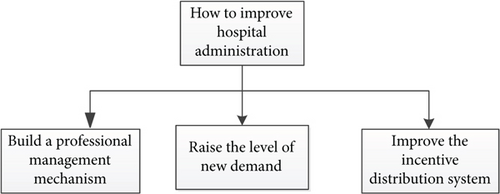
3. Fuzzy Hierarchical Model
3.1. AHP
AHP decomposes complex objective problems into different unit factors, and each unit factor is divided into several groups according to different attributes, thus forming several levels. The top factor is the goal, the middle level is the standard, and the bottom level is the plan, forming a descending hierarchy of dominance, as shown in Figure 3.
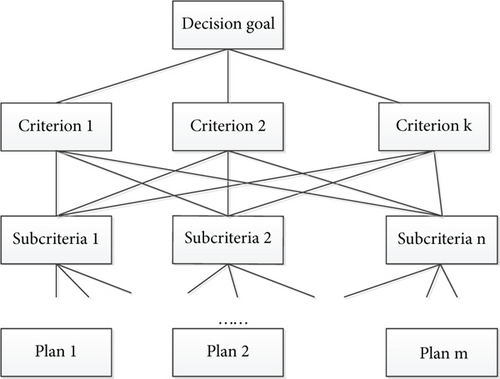
AHP integrates the principle of pairwise comparison. By comparing two factors in pairs, determine the relative importance of the two factors, and create an evaluation matrix based on this. A final decision is then made as to whether the allocation is appropriate.
Shapes are then measured through single-level sorting and hierarchical multilevel sorting, and the preferred solution is determined based on the measurement results.
3.2. Mathematical Model of Fuzzy AHP
The combination of obscure mathematics and the AHP process creates the fuzzy AHP (FAHP) process. The complexity of the objective world and the constant change of perpetual motion machines mean that the world presents random uncertainty and a more general uncertainty and ambiguity. With the development of science, more and more contradictions are encountered, and one of the most prominent contradictions is the contrast between ambiguity and precision. However, in some cases, a certain amount of blur may appear more precise, while overprecision may appear blurry.
then, such a matrix is called a fuzzy complementary judgment matrix.
When aij = 0.5 is equal, it means that factor Xi is equally important as factor Xj; when aij > 0.5, it means that factor Xi is more important than factor Xj; when aij < 0.5, it means that factor Xj is more important than factor Xi.
When aij = 0.5, the factor Xi is equally important as the factor Xj; when aij > 0.5, the factor Xi is more important than the Xj factor; when aij < 0.5, the factor Xj is more important than the Xi factor.
The formula contains the correct properties and scoring information for an ambiguous consensus scoring matrix. The calculation amount is small, and the application is simpler. This is a general formula for solving the dark complementary score matrix weighting formula.
Whether the weight value obtained by formula (10) is appropriate is evaluated by the consistency test. If the offset consistency is too large, the weight values will be unreliable.
I is the compatibility index of A and B.
W is the attribute matrix of the score matrix A.
If the compatibility index I(A, W) is less than or equal to the @ set by the decision-maker, it means that the consistency meets the requirements; the smaller the @ is, the higher the decision-maker’s consistency requirements are, usually @ = 0.1.
When the compatibility index I(A, W) is less than or equal to the decision-maker’s attitude @, it means that the consistency is in line with the requirements; the smaller the @ is, the higher the decision-maker’s requirements for consistency, generally desirable @ = 0.1.
3.3. Establishment of the Improved Fuzzy Analytic Hierarchy Process
Although AHP based on an ambiguous scoring matrix overcomes some shortcomings of traditional AHP, it is difficult to ensure the consistency of the ambiguous scoring matrix, and the final calculation results are not satisfactory. It is an ideal decision-making method to introduce the concept of the ambiguous consistent matrix and choose a more reasonable plan accordingly.
Then, R is said to be a fuzzy matrix.
Then, the fuzzy matrix R is called a fuzzy complementary matrix. The nature of reflects the consistency of people’s thinking and judgment. When factor I is more important than factor J and factor J is more important than factor K, factor I must be more important than factor K. When factor I is less important than factor J and factor J is less important than factor K, factor I must be less important than factor K.
Among them, rij = 0.5, which means that factor i and factor j are equally important; 0 ≤ rij ≤ 0.5 means that factor j is more important than factor i, and the smaller rij is, the more important constraint j is than factor i; 0.5 ≤ rij ≤ 1 means that factor i is more important than factor j, and the larger rij is, the more important the factor i is than the factor j.
- (1)
Clarify decision-making goals, determine object attributes, and establish an index system
- (2)
Formulate the contents of the expert consultation letter, select the expert consultation, and summarize the calculation consultation results. The answers obtained will directly affect the calculation results of the fuzzy analytic hierarchy process and the actual effect of the application
- (3)
According to the fuzzy analytic hierarchy process calculation steps and corresponding formulas, perform hierarchical single ranking, calculate the priority value, obtain the average priority value, calculate the final evaluation value in combination with the weight, and finally perform a total hierarchical ranking
- (4)
Evaluate each scheme according to the final calculation result, and select the optimal scheme
4. Analysis and Application of the Quality Index Based on the Fuzzy Hierarchical Model in Hospital Administration
4.1. Constructing the Quality Index System in Hospital Administration
To build the quality index system in hospital administration, firstly, the quality indexes in hospital administration are divided into two parts. The first-level indexes are from four aspects: work performance, work ability, work attitude, and satisfaction; the second-level indexes have a total of 17, which are goal achievement, work efficiency, work quality, cost control, management ability, communication and coordination ability, adaptability, innovation ability, analytical judgment, overall concept, leading by example, diligence, execution, morality, words and deeds, and leadership satisfaction. 17 impact factors were assigned and calculated to form quantitative evaluation indicators, as shown in Table 1.
| First-level indicator | Secondary indicators |
|---|---|
| Work performance | Goal achievement |
| Work efficiency | |
| Work quality | |
| Cost control | |
| Ability to work | Management ability |
| Communication and coordination ability | |
| Resilience | |
| Creativity | |
| Executive power | |
| Analytical judgment | |
| Work attitude | Global concept |
| Lead by example | |
| Diligent | |
| Moral words and deeds | |
| Satisfaction | Leadership satisfaction |
| Employee satisfaction | |
4.2. Screening of the Index System by the Delphi Expert Consultation Method
A total of 20 experts participated in the screening work. A total of 20 consultation forms were distributed, 20 were recovered, and 20 were valid. The effective recovery rate was 100%. Through statistical analysis of the first-level indicators, the arithmetic mean of work performance is 4.89, which meets the threshold standard; the arithmetic mean of work ability is 4.83, which meets the threshold standard; the arithmetic mean of work attitude is 4.56, which meets the threshold standard; in satisfaction, the arithmetic mean of the degree is 4.17, which meets the cutoff criterion, as shown in Table 2.
| First-level indicator | Arithmetic mean |
|---|---|
| Work performance | 4.89 |
| Ability to work | 4.83 |
| Work attitude | 4.56 |
| Satisfaction | 4.17 |
| Mean | 4.61 |
| Standard deviation | 0.57 |
| Threshold | 4.04 |
It can be seen from Figure 4 that the statistical analysis of the first-level indicators shows that the full score ratio of work performance is 0.89, and the coefficient of variation is 0.27, which both meet the threshold standard; the full score ratio of work ability is 0.83, and the coefficient of variation is 0.33, all of which meet the threshold standard. The full score ratio of work attitude is 0.72, and the coefficient of variation is 0.64, all meeting the threshold standard; the full score ratio of satisfaction is 0.33, and the coefficient of variation is 0.78, all meeting the threshold standard.
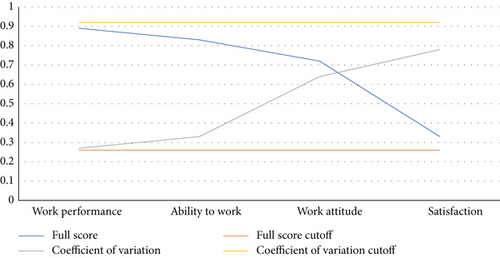
After summarizing the expert scores, calculate the arithmetic mean, full score ratio, and coefficient of variation of each indicator. In this way, each indicator has three judgment scales. In order to avoid the exclusion of important indicators, the exclusion criteria of the specially set indicators are as follows: any indicators with more than two judgment scales that do not meet the threshold standard will be excluded. From Table 2 and Figure 4, it can be judged that the first-level indicators do not meet the set index exclusion criteria, so the first-level indicators are retained.
From Table 3, it can be seen that the arithmetic mean of target achievement is 13.44, the full score ratio is 61, and the coefficient of variation is 0.65, which meets the threshold standard; the arithmetic mean of work efficiency is 13.67, the full score ratio is 56, and the coefficient of variation is 0.55, which meets the threshold standard. The arithmetic mean of work quality is 13.67, the full score ratio is 56, and the coefficient of variation is 0.55, which meets the threshold standard; the arithmetic mean of cost control is 13.67, the full score ratio is 56, and the coefficient of variation is 0.55, which meets the threshold standard; the arithmetic mean of management ability is 13.11, the full score ratio is 44, and the coefficient of variation is 0.63, which meets the threshold standard; the arithmetic mean of communication and coordination ability is 13.11, the full score ratio is 50, and the coefficient of variation is 0.66, which meets the threshold standard; the arithmetic mean of strain capacity is 12.33, the full score ratio is 38, and the coefficient of variation is 0.83, which meets the threshold standard; the arithmetic mean of innovation ability is 13.11, the full score ratio is 50, and the coefficient of variation is 0.7, which meets the threshold standard; the arithmetic mean of analytical judgment is 13.22, the full score ratio is 56, and the coefficient of variation is 0.74, which meets the threshold standard; the arithmetic mean of the global concept is 12.67, the full score ratio is 44, and the coefficient of variation is 1.07, which meets the threshold standard. The arithmetic average is 12.22, the full score ratio is 33, and the coefficient of variation is 0.81, which meets the threshold standard; the arithmetic mean of execution is 13.78, the full score ratio is 61, and the coefficient of variation is 0.55, which meets the threshold standard. The ratio is 33, and the coefficient of variation is 0.81, which meets the threshold standard; the arithmetic mean of leadership satisfaction is 12.11, the full score ratio is 22, and the coefficient of variation is 0.76, which meets the threshold standard; the arithmetic mean of employee satisfaction is 13.11, and the full score ratio is 50. The coefficient of variation was 0.76, which met the threshold standard; the secondary indicators also met the conditions.
| Secondary indicators | Arithmetic mean | Full score | Coefficient of variation |
|---|---|---|---|
| Goal achievement | 13.44 | 61 | 0.65 |
| Work efficiency | 13.67 | 56 | 0.55 |
| Work quality | 13.67 | 56 | 0.55 |
| Cost control | 12.22 | 22 | 0.81 |
| Management ability | 13.11 | 44 | 0.63 |
| Communication and coordination ability | 13.11 | 50 | 0.66 |
| Resilience | 12.33 | 38 | 0.83 |
| Creativity | 13.11 | 50 | 0.7 |
| Executive power | 13.78 | 61 | 0.55 |
| Analytical judgment | 13.22 | 56 | 0.74 |
| Global concept | 12.67 | 44 | 1.07 |
| Lead by example | 12.33 | 50 | 1.05 |
| Diligent | 12.22 | 39 | 0.96 |
| Moral words and deeds | 12.22 | 33 | 0.81 |
| Leadership satisfaction | 12.33 | 22 | 0.76 |
| Employee satisfaction | 13.11 | 50 | 0.76 |
| Mean | 12.88 | 46.05 | 0.77 |
| Standard deviation | 0.74 | 3.61 | 0.39 |
| Threshold | 12.14 | 41.6 | 1.16 |
4.3. Weight Value of the Quality Index System in Hospital Administration
According to the method, the weight of the first-level indicators is calculated, and the importance is sorted. It can be seen from Table 4 that the highest weights in the first-level indicators are work performance and work ability, with a weight of 0.35; the weight of satisfaction is the lowest, with a weight of 0.1; and the weight of work attitude is 0.2.
| First-level indicator | The average score | Weights |
|---|---|---|
| Work performance | 4.53 | 0.35 |
| Ability to work | 4.47 | 0.35 |
| Work attitude | 3.07 | 0.2 |
| Satisfaction | 1.67 | 0.1 |
In work performance, goal achievement, work efficiency, and work quality have the largest weights, with a weight of 0.3, and cost control has the smallest weight, with a weight of 0.1; in work ability, execution and management capabilities have large weights, with a weight of 0.225; the weight of coordination and communication ability, adaptability, analysis, and judgment is the smallest, the weight value is 0.125, and the weight value of innovation ability is 0.175; in the work attitude, the overall concept and leading by example have the largest weight value, and the weight value is 0.3, followed by morality, words and deeds, and diligence; in satisfaction, employee satisfaction has the largest weight, with a weight value of 0.6, followed by leadership satisfaction, with a weight of 0.4, as shown in Figure 5.
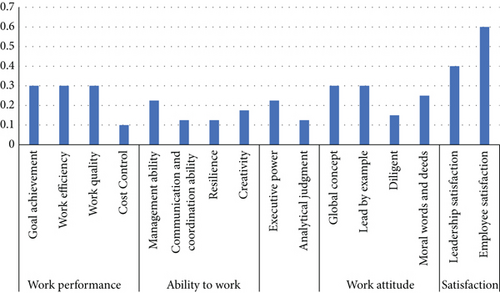
In the work performance, the “very good” has the highest rating for the achievement of the goal, with a rating of 0.41. In cost control, the evaluation value is 0.21; the work quality has the largest evaluation value of “poor,” and the evaluation value is 0.16; in the work ability, the analysis judgment has the evaluation value of “very good,” and the evaluation value is 0.38. Innovation ability has the highest value of “good,” which is 0.45; management ability has the highest value of “good,” and the value of “poor” is 0.37. Communication and coordination ability has the highest value of “poor,” which is 0.28; in the work attitude, morality and words and deeds have the highest value of “very good,” and the value of “good” is 0.42; overall concept and leading by example have the highest value of “good,” the value of “very good” is 0.39, and the value of “good” is 0.39. The overall concept has the largest value, and the evaluation value is 0.24; the most diligent have the “poor” evaluation value, and the evaluation value is 0.21; in the satisfaction, the largest employee satisfaction has the “very good” evaluation value, and the evaluation value is 0.21. It is 0.42. The “good” comment value is the largest for leadership satisfaction and employee satisfaction, and the comment value is 0.22; the “good” comment value is the largest for the leadership satisfaction, and the comment value is 0.4; and the “poor” comment the highest value for employee satisfaction, with a comment value of 0.09, as shown in Figure 6.
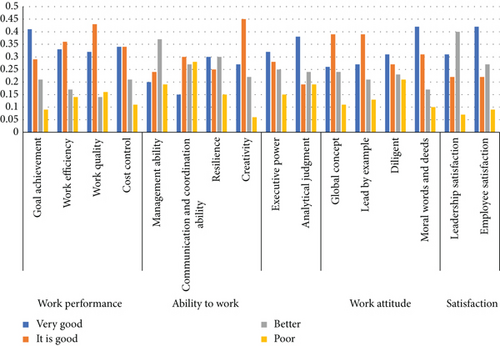
As can be seen from Table 5 and Figure 7, the overall ranking of management ability in the secondary indicators has the largest weight, with a weight of 0.0837, followed by work efficiency, diligence, cost control, morality, communication and coordination, work quality, innovation ability, goal achievement, employee satisfaction, leadership satisfaction, adaptability, execution, analytical judgment, overall concept, and leading by example.
| First-level indicator | Secondary indicators | Hierarchical single sorting weights | Hierarchical total ranking weight |
|---|---|---|---|
| Work performance | Goal achievement | 0.3 | 0.064 |
| Work efficiency | 0.3 | 0.0797 | |
| Work quality | 0.3 | 0.0641 | |
| Cost control | 0.1 | 0.084 | |
| Ability to work | Management ability | 0.225 | 0.0836 |
| Communication and coordination ability | 0.125 | 0.071 | |
| Resilience | 0.125 | 0.0517 | |
| Creativity | 0.175 | 0.065 | |
| Executive power | 0.225 | 0.051 | |
| Analytical judgment | 0.125 | 0.0472 | |
| Work attitude | Global concept | 0.3 | 0.0455 |
| Lead by example | 0.3 | 0.034 | |
| Diligent | 0.15 | 0.0767 | |
| Moral words and deeds | 0.25 | 0.0725 | |
| Satisfaction | Leadership satisfaction | 0.4 | 0.054 |
| Employee satisfaction | 0.6 | 0.056 | |
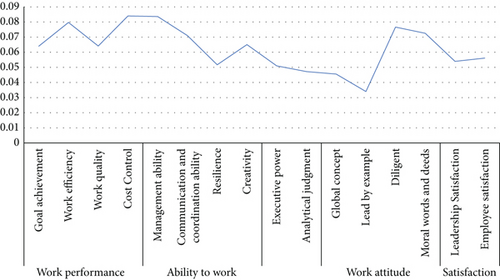
4.4. Adjustment of Indicator Weights for Department Categories
According to the department’s management responsibilities, characteristics, and daily assessment, according to the weights determined by the index system in the management line, and through expert points, the index weights are adjusted for departments with different work characteristics and their actual work conditions. In the service guarantee department, the weight of work performance before adjustment is 35%, the weight after adjustment is 30%, and the weight is reduced by 5%; the weight of work ability before adjustment is 35%, the weight after adjustment is 20%, and the weight is reduced by 15%; the weight before work attitude adjustment is 20%, and the weight after adjustment is 25%, with an increase of 5%; the weight of satisfaction before adjustment is 10%, and the weight after adjustment is 25%, with an increase of 15%, as shown in Figure 8.
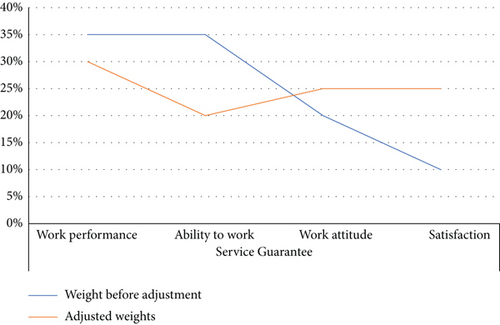
As can be seen from Figure 9, in the technical management department, the weight of management ability has been increased from 20% to 30%, the weight of coordination ability has been reduced from 10% to 5%, and the weight of innovation ability has been reduced from 15% to 5%. In party and government management, the weight of executive power was raised from 25% to 30% and the weight of analysis and discrimination ability was lowered from 10% to 5%. In service guarantee, the weight of adaptability has been increased from 10% to 20%, the weight of coordination and communication ability has been increased from 10% to 15%, the weight of analytical judgment has been increased from 10% to 15%, and the weight of management ability has been reduced from 20% to 10%.
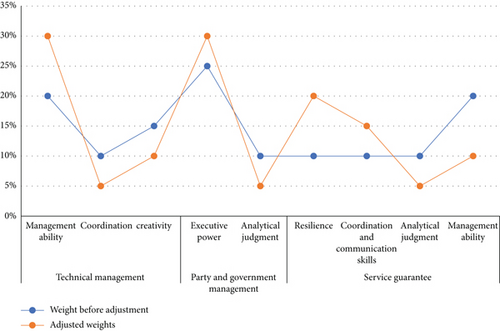
5. Conclusions
The design of the hospital management quality index system can further decompose the concept of equality and fanaticism and guide managers to fully understand and improve this phenomenon, regardless of work efficiency and quality, work responsibility and effort, and work risk and ability. At the same time, use scientific and affordable financial means to mobilize the enthusiasm of employees and better complete the tasks of individuals and departments. In line with the principle of ensuring the implementation of the hospital’s strategic goals and the completion of the mission of the public hospital, more emphasis is placed on the priority of efficiency. Pay attention to understanding, recognize personal value, ensure that personal interests are properly protected, and accelerate the formation of a hospital cultural atmosphere in which people and hospitals share risks, share responsibilities, and balance income and expenditure. The hospital administrative code system established at this stage makes up for the weak incentive effect, weak guiding effect, and lack of close integration with administrative management in the initial program. The system has been introduced one by one, and the quality index system within the hospital management department has also appeared insufficient in the testing activities, which should be improved as soon as possible.
Conflicts of Interest
The author declared that he has no conflicts of interest regarding this work.
Open Research
Data Availability
The experimental data used to support the findings of this study are available from the corresponding author upon request.




